The new breed of super trucks are renowned for their quality and their reliability. Bob Bluffield traces how the vehicle requirements of the industry have developed over the years to meet a changing market and a more challenging environment.
Bob Bluffield traces how the vehicle requirements of the industry have developed over the years to meet a changing market and a more challenging environment.
When I recently asked a number of industry decision makers to tell me what influences their choice when buying vehicles, the overwhelming factor used as a yardstick boiled down to one thing - reliability. In view of this it was not surprising to hear that Scania, DAF and Volvo have become prominent in a domestic market that was once populated by British built vehicles. I guess the disappearance of British built lorries has largely been due to globalisation and the way that the UK's one time lead as a manufacturing nation has dramatically diminished. But what happened to the famous marques that once graced our highways? All quietly slipped into obscurity, with only a few remaining examples being preserved that are rolled out at the occasional rally as a reminder that Britain once had a road haulage heritage. Atkinson became absorbed by Iveco; Bedford fell under the General Motors umbrella; AEC ceased as a brand in 1977; Guy closed in 1982; Ford stopped making large trucks and Foden and Leyland both vanished in their own right to become part of the mighty PACCAR empire who also own DAF. Now, the road haulage and removal industries are dominated by the European giants; DAF, Scania, Volvo, Mercedes, MAN, Iveco and, to a lesser extent, Renault.
The new breed of super trucks are renowned for their quality and their reliability and they are praised by the majority of operators that own them. In the North East of England, Mike Deveraux told me: "It really is a no brainer. I always choose my vehicles for reliability and for no other reason. I haven't bought any trucks for quite some time, and although we have a couple of Mercedes with bodies built by Sparshatts, I now prefer Scania or DAFs." Deveraux has eight vehicles in its fleet, mainly rigid but with a few tri-axle articulated units.
Reliability is foremost in the mind of Ian Palmer of Hampshire-based White and Company who operates a large fleet of 210 vehicles. "I look for reliability over the whole life of the vehicle. We always buy Scania for the heavy work and MAN for lighter duties. We have Scania P230 rigids plated to 18 tonnes and recently bought 12 new Scanias and have six MAN vehicles on order plus four Montracon trailers." Ian explained how impressed he is by the European-wide network of Scania dealerships that means spares are readily accessible across the continent. "Although this is of course subjective, we have never been able to find the service levels we have been offered by Mercedes comparable and this is another reason why we favour Scania."
Today's vehicles by necessity are more efficient, cleaner, more practical and considerably more comfortable, but they also have to satisfy a number of different requirements. With new vehicles costing £70,000-£90,000 they are more expensive as well, so making the right chassis choice is crucial if you are to get the best from a vehicle. Tougher environmental regulations and the increasing price of diesel - now costing more in the UK than in the majority of other European states - makes economy and low emissions also a priority. These factors could inspire a growth in the use of hybrid vehicles for shorter distances in the near future. DAF has already announced that its 12-tonne LF Hybrid has gone into production at Leyland in the UK, Volvo has tested its FM Hybrid dustcart in London and Ford has conducted research, with 20, albeit much smaller vehicles used by FedEx in Los Angeles and Sacramento. However, larger vehicles suitable for removal work equipped with a diesel engine and electric motor could still be a considerable way off.
Robert Bartup of GB Liners has retained his faith by buying DAF because he believes "... they can supply the complete range of chassis that we need." His fleet of 75 vehicles consists of DAF LF and CF chassis ranging from 7.5 tonnes up to 18 tonnes that are likely to have a working life of up to ten years.
It was recently reported that Bangor-based McGimpsey has unveiled a new tractor unit with a Euro 5 compliant engine capable of returning 9.5 mpg that breaks with their tradition of buying Mercedes. This, the first of its kind in Ireland, is the Iveco Stralis Active Space Saver Super, a magnificent unit with a high-spec cab that Paul McGimpsey describes as "... better finished and more comfortable than some up-market hotel rooms." It was delivered with an impressive range of factory fitted options included within the price. In addition to the separate cab airbag suspension, automatic gearbox and third crew seat behind the front seats; the full-height sleeper cab includes two full size single beds, a fridge, freezer, television, heated seats, electric window blinds and fold down table. On a more serious note, the Euro 5 rated tractor unit has a sophisticated tracking system to record miles per gallon, speed, gear changes and other parameters to indicate whether the vehicle is being driven smoothly or aggressively.
Britannia Lanes, the Devon family-owned firm, previously operated an all-DAF fleet but has also introduced a chassis change by acquiring a Volvo FM for use on their weekly trips to Germany. This has a 13 litre engine and 630 litre fuel tank to give a range of up to 1,000 miles and uses a demountable swap body system with a drawbar trailer that provides Lanes with the flexibility it requires.
As an outsider with no prior connections with the industry I had not appreciated just how much removal vehicles have changed. How many members of the public, I wonder, would paint a picture of a large box van if asked to illustrate what a removal lorry looks like? These were referred to as pantechnicons - a name I have not heard for years that was derived from the Greek - pan meaning 'all' and technikon; 'piece of art' - that was adopted by a London bazaar that sold art but later became a furniture warehouse.
Box vans, for their practicality, have of course been the traditional vehicles since the birth of the removal industry. Things have moved a long way with containers and removable bodies - but essentially moving household belongings requires a box on wheels. In the 19th and 20th centuries horses were used over short distances, at first to haul carts, and later box vans. Most house removals were over a few miles and involved local firms but Lewis of Barnstaple (established in 1835) at one time moved its customers by train using horses hired from the Great Western Railway to haul its box vans at either end of a rail link. In Yorkshire, Hanson, (now Hanson Logistics) up until 1939 maintained a stable of 400 working horses despite introducing steam powered lorries in 1913 with the purchase of a steel-tyred Foden for furniture removals. By the 1920s the development of petrol engines made moving items by road more realistic and removal companies began to re-style some of their box vans to make practical use of the area above the vehicle cab. A haulier from Luton, B E 'Bertie' Barratt, developed the idea and called the body style 'Luton' after the Bedfordshire town where he worked and the name stuck.
Luton bodies remained the mainstay of many firms although improvements were made over the years by fitting wide side doors to provide easy access. An increase in long distance and European removals has made the Luton less popular per se as companies employ the space to be used as a sleeper pods with aerodynamic styling. The drawback is that a sleeper pod reduces storage space. An 18-tonne vehicle can accommodate a 28-32 foot body with 2200 to 2450 ft3 (62.29 to 69.38 m3) of storage, but a sleeper pod will reduce this by up to 160 ft3 (4.53 m3).
Body type requirements differ depending on the type of work undertaken. Britannia Lanes, who operates 40 vehicles from small panel vans necessary when negotiating the tight lanes of its West Country locality, to its latest specialist road train that uses interchangeable CT boxes. This provides flexibility that allows more than one load to be transported on the same vehicle that helps to reduce its carbon footprint.
Some companies use removable vehicle bodies and containers that can be left at a customer's premises for self loading but these can be problematic if they are overloaded or the weight is inappropriately distributed.
When I asked Robert Bartrup of GB Liners what kind of bodies he preferred, this was not intended to be an innuendo, but after laughing he responded well by saying: "I still rely on proper coach built removal vans that we have custom built by Unique Van Bodies of Warrington with sleeper cabs or pods. We also operate a few road trains but I don't favour lift-on, lift-off bodies." Ian Palmer told me that: "White and Company use rigids, road trains and artics with three-bunk sleeper cab configurations on some vehicles and twin-bunk pods in others."
Steve Thompson of Essex Bodies explained: "As many companies are moving away from short, local removals, the old-style Luton body is less popular and there is a switch to more use of sleeper pods and vehicles are getting bigger. Space cabs with sleeping accommodation are also growing in popularity and I would say that DAF, Iveco and Scania are now the most common chassis that we work with." He also believed that after a very tough period the industry is now starting to "turn the corner. I am getting more enquiries but there are less chassis available and people are having to wait longer for them".
Norfolk-based Vancraft provides sleeper pod accommodation for up to four people with seating for up to eight in the vehicles they build. They appreciate that for some, cost and availability can be a problem and say that a solution can be found by buying second-hand. A refurbished chassis with new bodywork typically will cost £40,000-£50,000 for a 5-year old, low mileage vehicle with a one year warranty. Against the cost (up to £90,000) of a new, custom built vehicle this can look extremely attractive.
As vehicle body type legislation that will affect the removal industry is destined for introduction by 2013 we will have to wait to see how this will change the shape of future vehicles.
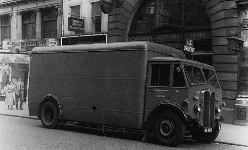
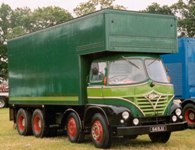
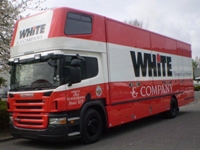
Top left: AEC vehicle from the 1950s; Centre: 1960s Foden S21 from the Len Rogers Collection, restored in 2004; Right: White & Co Scania 220. This 18-tonne GVW has a 9-tonne payload, carries five containers and has acommodation for two with night heating and hot and cold washing facilities.
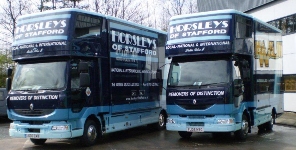
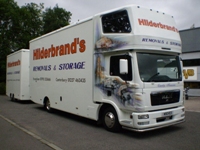
Left: Horsley of Stafford 7.5-tonne vehicles, one (right) with shortened body (900ft3) for easy access, offering 3.25-tonne payload; Right: Hilderbrands road train. The MAN-180 tow unit is a 7.5-tonne GVW with a 3-tonne payload. The trailer adds an additional 2-tonne payload;
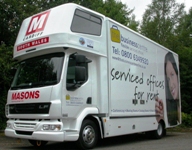
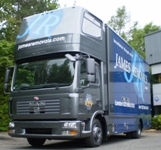
Left: Masons of Cardiff DAF 45-180 7.5-tonne. It features a lightweight box body with 1246ft3 capacity. Right: James Removals MAN-180 10-tonne GVW with 3.8-tonne payload. This carries three containers (two from side and one from rear), and can accommodate two.
All photos courtesy of Unique Van Bodies.